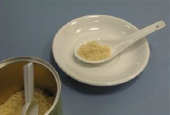Beware! Choose Sodium-Based Seasonings at Your Own Risk
|
Salt is an essential seasoning, for it enhances the natural taste of food and makes dishes more delightful. Sodium in salt is also one of the most important electrolytes in the human body. However, excessive intake of sodium may increase the risk of hypertension. Hence, the World Health Organization (WHO) recommends adults to limit their intake of sodium to no more than 2 000 mg per day.1 |
What are high-sodium foods? |
As people are getting more health-conscious these days, food manufacturers are releasing products like natural sea salt and chicken powder as healthier alternatives of table salt. These products are more expensive, yet, are they really healthier options compared to table salt?
Natural Sea Salt
Natural sea salt is usually marketed for their rich mineral content. Results (see table below) from the Centre for Food Safety show that sea salt is higher in potassium compared to table salt. Yet, both types of salt are almost identical in their sodium, phosphorus and calcium contents. Needless to say, it is infeasible to meet the recommended daily intake of potassium, phosphorus and calcium just by consuming salt alone. For instance, we would have to consume about 8 330 g of sea salt (around 24 bottles) to meet the recommended daily intake of potassium. Indeed, a balanced diet is the best way to attain the recommended daily intake of various minerals. It is unnecessary to boost up our mineral intake by consuming sea salt. Furthermore, as sea salt and table salt both contain significant amount of sodium, watch out on the amount you use to avoid excessive sodium intake.
Comparison between Table Salt and Natural Sea Salt:
| Per 100g | Table Salt2 | Natural Sea Salt2 | Recommended Daily Intake for Adults2,3 |
|---|---|---|---|
| Sodium(mg) | 38 000 | 37 000 | 2 000 |
| Potassium(mg) | 17 | 24 | 2 000 |
| Phosphorus(mg) | 3 | 3 | 720 |
| Calcium (mg) | 34 | 34 | 1 000 |
Chicken Powder

The market is nowadays flooded with chicken powder advertisements, leading to the common belief that chicken powder is a healthier substitute of salt. Having a lower sodium content than salt does, chicken powder is nevertheless still a high-sodium food (24 000 mg of sodium per 100 g of chicken powder). Thus, if we use chicken powder recklessly at cooking due to its lower sodium content, we may consume more sodium than before. In short, we should control our use of salt. Don’t be too generous with it, or we will risk taking in too much sodium.
All in all, natural sea salt and chicken powder are both high-sodium seasonings. When we use any sodium-based seasoning, it is important to control the amount we use. Alternatively, consider the use of natural ingredients like ginger, spring onion, garlic, ground pepper, herbs, coriander and onions to enhance the taste of food. This makes your dishes healthier by reducing the use of sodium-based seasonings.
To know more about …
- healthy eating, please visit ‘Health Zone’ website at http://www.cheu.gov.hk
- ‘Health@work.hk Project’, please visit http://www.healthatwork.gov.hk
1World Health Organization
2Centre for Food Safety
3Chinese Dietary Reference Intakes 2013, Chinese Nutrition Society
 Top
Top



